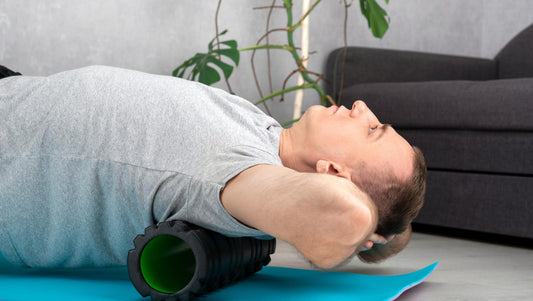Or maybe put better, how to get big wins with your foam roller.
When we’re talking about foam rolling, we’re usually thinking about two different ideas; recovery, and corrective work.
A lot of us foam roll for recovery, to alleviate delayed onset muscle soreness (DOMS) or release a 'tight area'. You should always be including some corrective work into your routine as well. Corrective work will safeguard the long-term health of your body and joints, and allow you to become more efficient, more mobile, and more injury-proof.
Foam rolling is an incredible way to support your body’s muscle recovery, enhance mobility, and prevent injuries. While it’s great to be able to understand the anatomy being influenced by your foam roller, let’s make sure you’re armed with actionable tips on how to actually 'foam roll' effectively.
Below, we’ll cover foundational knowledge and step-by-step guidance to get you rolling in no time.
Why Foam Rolling Matters
Foam rolling serves two primary purposes: recovery and corrective work.
Recovery helps soothe sore muscles and improve blood flow after activity; Corrective work addresses the underlying structural imbalances in your body that lead to pain or limited mobility. For long-term health, the application of both is key.
First, a quick metaphor. Your spine is like the frame of your car. If it has any twist in it, your tires will wear on one side more than the other, the suspension will be crooked and need to be replaced more often…..And you definitely don’t want to add more power to a crooked frame.
The body works in the exact same way. Little twists in your spine mean your hips and knees aren’t level. You can get achy joints. Putting more muscle on your frame might even compound the problem instead of make you stronger. Foam rolling helps realign your foundation—your spine and surrounding structures—so your entire body functions more efficiently.
Step-By-Step: How to Foam Roll Key Areas
Here are the top three places to start your lifelong addiction to foam rolling.
Grab your RAD Roller and get started.
Remember to begin using light pressure and gradually increase as you build tolerance. Do not apply your full body weight immediately.

1. Thoracic Spine (Middle Back)
Why it matters:
The thoracic spine, or T-spine for short, is the middle part of the spinal column that all of your ribs attach to. Above it is the neck, and below it is the lower back. The T-spine is incredibly important because it is incredibly underused by modern humans. Too much sitting weakens the area, which in turn affects the surrounding soft tissues.
Why is this an issue? Breathing, for one. Your T-spine expands and contracts with every breath. If it’s not moving properly you will overload all the muscle tissue in the little muscles of the neck that help to raise the chest up for a full breath.
How to roll out your T-Spine:
-
Sit on the floor with your foam roller placed horizontally under your upper back.
-
Lie back so the foam roller supports your mid-back, keeping your knees bent and feet flat on the floor.
-
Cross your arms over your chest or place them behind your head.
-
Slowly roll from the base of your ribcage to just below your shoulders. Roll slowly over tight spots and take slow, steady, deep breaths.
Pro tip: Avoid rolling directly on your lower back as this can strain the area.
2. Upper Neck
Why it matters:

The upper neck is a great area to focus on. You'll get a lot of bang-for-your-buck because it houses your ‘mission control center’, aka your brain. It also holds your eyes and ears, which contribute to keeping your body level in space. If you’ve got tension on one side of your neck, it’s very common to see the whole body twist to compensate. Your whole body will shift in an attempt to keep your eyes level with the horizon. If your neck is crooked, your gaze is not even, and this cascades down to all other muscle groups…. All because of a little neck tension. Spending just a few minutes rolling out your neck can help realign the whole body below it.
How to roll:
-
Lie down and place a small massage ball or foam roller underneath the base of your skull.
-
Gently nod your head up and down or tilt it side to side to target tension points.
-
Spend 1-2 minutes on each side, breathing deeply. After spending 1-2 minutes on one side, switch legs to ensure balanced treatment.
Pro tip: Use a soft foam roller or ball for this sensitive area to avoid discomfort.
3. Hips
Why it matters:

A lot of people ask us about lower back pain, and the easiest place to start 'releasing' the lower back is in the hips. In a perfect world, the hips would move unrestricted in all directions, allowing the lower back to stay aligned in a nice column, supporting the rest of the back.
In most cases, the hips can’t move very much, forcing the lower back to bend, twist, and generally overwork itself to pull off even the most simple of motions. Acute low back pain episodes are often caused by people getting out of bed or bending over to tie their shoes, and then bang! Huge pain. Don’t be that guy. Spend a little time on your hips and you'll never need to fear tying your shoes or picking up your socks ever again.
Foam rolling can help unlock tight hips by targeting the surrounding muscles, improving the overall range of motion, and reducing stress on the lower back.
How to roll:
-
Sit on the foam roller, leaning slightly to one side to target your glute muscles.
-
Slowly roll from the top of your hip to the base of your glute.
-
Switch sides and repeat.
-
To target hip flexors, lie face down with the roller under the front of your hips. Gently roll back and forth.
Pro tip: Combine rolling with hip stretches for maximum relief.
Common Foam Rolling Mistakes to Avoid
-
Rolling too fast: Slow, controlled movements are more effective for releasing tension.
-
Overdoing it: Don’t spend more than 1-2 minutes on each area to prevent irritation.
-
Skipping warm-ups: Foam rolling is most effective when muscles are slightly warm.
Another Analogy:
Your body is like a house. If the foundation is crooked, the walls will crack and the roof won’t sit right. Foam rolling helps level your foundation so every “room” in your body—your joints and muscles—can function properly. By foam rolling the right areas, you can align your body for better strength training and injury prevention. By avoiding these common mistakes, you can ensure that your foam roller exercises are both safe and effective.
Ready to Roll?
Foam rolling is a simple yet powerful tool for recovery and mobility. With consistent practice, you’ll notice improved posture, reduced pain, and greater freedom of movement as your muscle fibers become more aligned and functional.
Grab your foam roller and start building a stronger, more resilient foundation today.
Happy rolling!




















